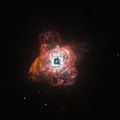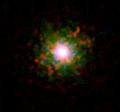Circinus facts for kids
| Constellation | |

List of stars in Circinus
|
|
| Abbreviation | Cir |
|---|---|
| Genitive | Circini |
| Pronunciation | Círcinus, genitive |
| Symbolism | Compass |
| Right ascension | 13h 38.4m to 15h 30.2m |
| Declination | −55.43° to −70.62° |
| Quadrant | SQ3 |
| Area | 93 sq. deg. (85th) |
| Main stars | 3 |
| Bayer/Flamsteed stars |
9 |
| Stars with planets | 2 |
| Stars brighter than 3.00m | 0 |
| Stars within 10.00 pc (32.62 ly) | 0 |
| Brightest star | α Cir (3.19m) |
| Messier objects | 0 |
| Meteor showers | Alpha Circinids (ACI) |
| Bordering constellations |
Centaurus Musca Apus Triangulum Australe Norma Lupus |
| Visible at latitudes between +30° and −90°. Best visible at 21:00 (9 p.m.) during the month of July. |
|
Circinus is a small, faint constellation in the southern sky, first defined in 1756 by the French astronomer Nicolas-Louis de Lacaille. Its name is Latin for compass, referring to the drafting tool used for drawing circles (it should not be confused with Pyxis, a constellation that represents a mariner's compass which points north). Its brightest star is Alpha Circini.
Notable features
The Milky Way runs through the constellation, the Alpha Circinids (ACI), a meteor shower also discovered in 1977, radiate from this constellation.
Meteor showers
Circinus is the radiant of an annual meteor shower, the Alpha Circinids (ACI). First observed in Queensland in 1977, the meteors have an average velocity of 27.1 km/s and are thought to be associated with a long-period comet. In 2011, Peter Jenniskens proposed that the debris trail of comet C/1969 T1 could intersect with the Earth's orbit and generate a meteor outburst. The ACI shower peaks on 4 June, the day it was first observed.
Images for kids
-
Hubble Space Telescope's view of NGC 5315, showing its intricate structure and central star
-
The Chandra X-ray Observatory's false-color image of Circinus X-1 showing its jets
See also
 In Spanish: Circinus para niños
In Spanish: Circinus para niños




